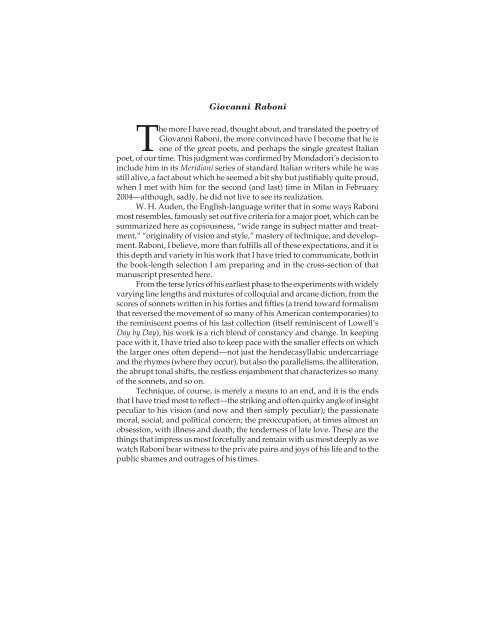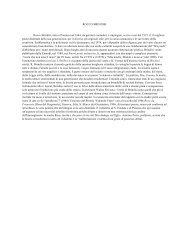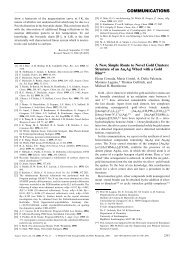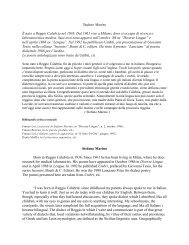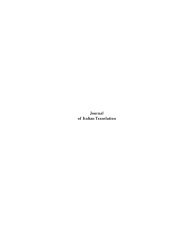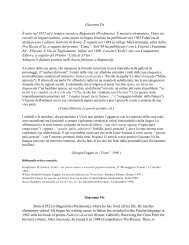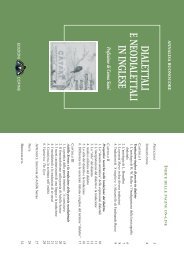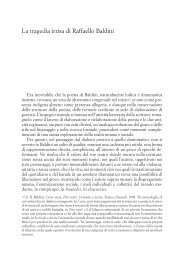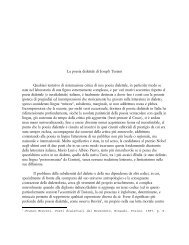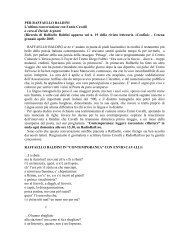Journal of Italian Translation
Journal of Italian Translation
Journal of Italian Translation
You also want an ePaper? Increase the reach of your titles
YUMPU automatically turns print PDFs into web optimized ePapers that Google loves.
Giovanni Raboni<br />
The more I have read, thought about, and translated the poetry <strong>of</strong><br />
Giovanni Raboni, the more convinced have I become that he is<br />
one <strong>of</strong> the great poets, and perhaps the single greatest <strong>Italian</strong><br />
poet, <strong>of</strong> our time. This judgment was confirmed by Mondadori’s decision to<br />
include him in its Meridiani series <strong>of</strong> standard <strong>Italian</strong> writers while he was<br />
still alive, a fact about which he seemed a bit shy but justifiably quite proud,<br />
when I met with him for the second (and last) time in Milan in February<br />
2004—although, sadly, he did not live to see its realization.<br />
W. H. Auden, the English-language writer that in some ways Raboni<br />
most resembles, famously set out five criteria for a major poet, which can be<br />
summarized here as copiousness, “wide range in subject matter and treatment,”<br />
“originality <strong>of</strong> vision and style,” mastery <strong>of</strong> technique, and development.<br />
Raboni, I believe, more than fulfills all <strong>of</strong> these expectations, and it is<br />
this depth and variety in his work that I have tried to communicate, both in<br />
the book-length selection I am preparing and in the cross-section <strong>of</strong> that<br />
manuscript presented here.<br />
From the terse lyrics <strong>of</strong> his earliest phase to the experiments with widely<br />
varying line lengths and mixtures <strong>of</strong> colloquial and arcane diction, from the<br />
scores <strong>of</strong> sonnets written in his forties and fifties (a trend toward formalism<br />
that reversed the movement <strong>of</strong> so many <strong>of</strong> his American contemporaries) to<br />
the reminiscent poems <strong>of</strong> his last collection (itself reminiscent <strong>of</strong> Lowell’s<br />
Day by Day), his work is a rich blend <strong>of</strong> constancy and change. In keeping<br />
pace with it, I have tried also to keep pace with the smaller effects on which<br />
the larger ones <strong>of</strong>ten depend—not just the hendecasyllabic undercarriage<br />
and the rhymes (where they occur), but also the parallelisms, the alliteration,<br />
the abrupt tonal shifts, the restless enjambment that characterizes so many<br />
<strong>of</strong> the sonnets, and so on.<br />
Technique, <strong>of</strong> course, is merely a means to an end, and it is the ends<br />
that I have tried most to reflect—the striking and <strong>of</strong>ten quirky angle <strong>of</strong> insight<br />
peculiar to his vision (and now and then simply peculiar); the passionate<br />
moral, social, and political concern; the preoccupation, at times almost an<br />
obsession, with illness and death; the tenderness <strong>of</strong> late love. These are the<br />
things that impress us most forcefully and remain with us most deeply as we<br />
watch Raboni bear witness to the private pains and joys <strong>of</strong> his life and to the<br />
public shames and outrages <strong>of</strong> his times.


